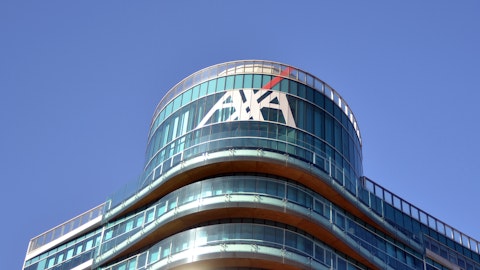First Hawaiian, Inc. (NASDAQ:FHB) Q4 2022 Earnings Call Transcript January 27, 2023
Operator: Good day, and thank you for standing by. Welcome to the First Hawaiian Fourth Quarter 2022 Earnings Conference Call. At this time, all participants are in a listen-only mode. Please be advised that today’s conference is being recorded. I would now like to hand the conference over to your speaker today, Kevin Haseyama, Investor Relations Manager. Please go ahead.
Kevin Haseyama: Thank you, Shannon, and thank you everyone, for joining us as we review our financial results for the fourth quarter of 2022. With me today are Bob Harrison, Chairman, President, and CEO; Jamie Moses, Chief Financial Officer; and Ralph Mesick, Chief Risk Officer. We have prepared a slide presentation that we will refer to in our remarks today. The presentation is available for downloading and viewing on our website at fhb.com in the Investor Relations section. During today’s call, we will be making forward-looking statements. So, please refer to Slide 1 for our safe harbor statement. We may also discuss certain non-GAAP financial measures. The appendix to this presentation contains reconciliations of these non-GAAP financial measurements to the most directly comparable GAAP measurements. And now, I’ll turn the call over to Bob.
Robert Harrison: Good morning, everyone. And I’d like to start by welcoming our new CFO, Jamie Moses. He brings us wealth of banking experience and proven track record in financial management. We’re excited to welcome Jamie to the bank. I also wanted to extend a special thanks to Ralph Mesick for his contributions as acting CFO over the last year until Jamie joined us. Now, a brief update on local economy. The Hawaii economy continues to do well. In December, the statewide unemployment rate fell to 3.2%, slightly below the national unemployment rate of 3.5%. Total visitor arrival grew 735,000 in November of last year, 9.1% below the November 2019 arrivals. Japanese visitor arrivals remained below historical levels at 3.8% of the total, compared to 16.3% in November of 2019.
We continue to expect a gradual return of Japanese visitors to more normalized levels. Despite the lower number of overall arrivals, visitors tend in November was $1.5 billion, up 13.7% over November 2019. The housing market has remained stable. In December, the median sales price for a single family home on Oahu was just over $1 million, unchanged from the year before. Median sales price for condos on Oahu was 503,000, 3.6% higher than the previous year. Turning to Slide 2. Comment on our fourth quarter results. We ended the year with a very good quarter as net income grew to 79.6 million or $0.62 per share. Loans grew, net interest income continued to increase while non-interest income returned to normalized levels and non-interest expenses was stabilized.

Photo by Ferran Fusalba Roselló on Unsplash
Our return on average tangible assets was 1.34%, and return on average tangible common equity was 25.93%. We continue to maintain strong capital levels with the CET1 ratio of 11.82% and total capital of 12.92%. The Board maintained a quarterly dividend of $0.26, and adopted a $40 million share repurchase program for 2023. Turning to Slide 3, the balance sheet continues to perform very well. It remains moderately asset sensitive with about 5.6 billion or 41% of the loan portfolio repricing within 90 days. We continue to use excess cash and the investment portfolio funded loan growth and deposit runoff. We ended the year with cash and cash equivalents at about $527 million, compared to where we started the year at $1.2 billion. The investment portfolio duration remained stable at 5.6 years for the quarter and cash flows from the portfolio was about 75 million per month.
Our liquidity position remains very strong with a 65% loan-to-deposit ratio, a strong core deposit base, and steady cash flows from the investment portfolio. Turning to Slide 4, period end loans to leases were 14.1 billion, an increase of $392 million or 2.9% from the end of Q3. About half of the growth was due to a $201 million increase in C&I loans, which was primarily due to $120 million increase in dealer flooring and $38 million increase in other dealer related loans. For all of 2022, total loans and leases were up 1.1 billion or 8.7%. Excluding PPP loans, total loans and leases were up $1.3 billion or 10.4%. We expect loan growth to be in the mid-single-digit range for full-year 2023. Now, I’ll turn it over to Jamie.
Jamie Moses: Thanks, Bob, and good morning, everyone. Turning to Slide 5, deposit balances decreased by $403 million or 1.8% to $21.7 billion at quarter-end. Retail and commercial deposits declined $668 million with most of that decrease coming from commercial deposit accounts. Commercial deposits declined by about $611 million, while retail balances were relatively stable declining by only $57 million. The five largest outflows from commercial accounts accounted for over $290 million, almost half of the total decline and were all part of normal business operations. Our total cost of deposits was 52 basis points in the fourth quarter, an increase of 28 basis points from the prior quarter and consistent with our expectations.
RAC rates on checking and savings accounts continue to remain stable. Turning to Slide 6, net interest income increased by $9.1 million or 5.6% over the prior quarter to $171.8 million. The increase was primarily due to higher yields and balances on loans, partially offset by higher deposit costs. The net interest margin increased 22 basis points to 3.15%, driven by higher yields on loans, cash and investment securities and was partially offset by higher rates on deposits. The acceleration in deposit costs can be seen in the fourth quarter beta, which is about 38% on interest bearing deposits. Our cumulative beta on interest bearing deposits to date of about 19% was within our expectations and we continue to expect that the full cycle beta will be about 30% on interest bearing deposits.
Looking forward, we expect net interest margin to increase by 4 basis points to 5 basis points in the first quarter. On to Slide 7, non-interest income was $48.2 million in Q4, a $2.3 million increase over the prior quarter. The improvement was due to the return of BOLI income to a normalized level as market volatility subsided in the fourth quarter. Expenses were $113.9 million, essentially unchanged from the third quarter. Using the fourth quarter non-interest expense as our new baseline, we expect that full-year 2023 expenses will be approximately 4% to 4.5% higher than the annualized fourth quarter number. If you exclude the impact of the increase of the FDIC assessment fee, which we estimate to be $4 million to $5 million annually, we expect 2023 expenses to be approximately 3% to 3.5% higher than that annualized fourth quarter number.
Now, I’ll turn it over to Ralph.
Ralph Mesick: Thank you, Jamie. Moving to Slide 8. The bank enjoyed good credit performance in 2022 and our asset quality metrics were strong year-end. Net charge-offs were down by $1.2 million year-over-year or almost 10%, and our annual net charge-off rate was 8 basis points, 2 basis points lower than in 2021. NPAs in 90-day pass through loans were 11 basis points at the end of Q4, up 1 basis point from the prior quarter. Criticized assets continue to decline dropping 9 basis points over the quarter to 72 basis points. The bank recorded a $3 million provision for the quarter. And finally, loans 30 to 89 days past due were $57 million or 40 basis points of total loans and leases at the end of Q4, 6 basis points higher than the prior quarter.
Moving to Slide 9, you see a roll forward of the allowance for the quarter by disclosure segments. Reserve needs for loan growth this quarter were again offset by improvements in the portfolio risk profile. The allowance for credit loss decreased $4.3 million to $143.9 million. The level equates to 1.02% of all loans. The reserve for unfunded commitments increased $3.7 million to $33.8 million based on an increase in undrawn exposures. The allowance anticipates cyclical losses consistent with every session and include a qualitative overlay for potential macroeconomic impacts not captured in our base model. Let me now turn the call back to Bob for any closing comments.
Robert Harrison: Thank you, Ralph. Thank you, Jamie. Nothing else to add. Welcome any questions. Kevin?
See also 15 Most Undervalued Quality Stocks To Buy and World’s Most Valuable Private Companies.
Q&A Session
Follow First Hawaiian Inc. (NASDAQ:FHB)
Follow First Hawaiian Inc. (NASDAQ:FHB)
Receive real-time insider trading and news alerts
Operator: Thank you. Our first question comes from the line of Steven Alexopoulus with J.P. Morgan. Your line is now open.
Steven Alexopoulus: Hi, everybody.
Robert Harrison: Hi, Steve.
Jamie Moses: Hi, Steve.
Steven Alexopoulus: I want to start, so I appreciate the loan outlook mid-single-digit, can you talk about the deposit growth outlook for the year? And in terms of the cost of deposits, I appreciate the 30% full cycle beta on interest bearing deposits, but how do you think about by the fourth quarter of 2023?
Jamie Moses: Yes. Well, that’s the question, isn’t it Steve? This is Jamie. Good morning. I think that €“ I think that that’s going to be entirely dependent on what we see macro if they said, it continues to increase, we’ll see deposit costs go up probably consistent with that beta that we described. And if they don’t, then we’ll probably see some stabilization here in rates in the first or second quarter. So, anything else there Bob?
Robert Harrison: Yes. No, just from the beginning of the cycle, we stayed very close to our customers and really taking care of them on deposit rates and making sure that we’re competitive. That will continue depending on where that goes with rates, but we’re comfortable and that we don’t see a lot of pressure on the consumer side to where we can still maintain a decent margin throughout the cycle.
Steven Alexopoulus: And then on the growth side, can you guys talk about that, you know 2022 used cash, right, to fund part of the loan growth? How are you thinking about that obviously have a lot of room because the loan to deposit ratio is still very low?
Robert Harrison: I think we’ll start as we have been funding it with the run off of the investment portfolio at that 75 million a month, that might slow a little bit, but still we’re in the 800 million plus range of investment flows for 2023. That’s the start and certainly that allows us to not only fund a good amount, if not all of the loan growth, but also if you take care of future deposit run-off should that happen.
Steven Alexopoulus: Okay. And then on the non-interest bearing outflows, is there a way to quantify what portion could be a risk? We’re seeing customers are investing some of that cash or chasing higher rate. Can you size for us? We’re trying to get a better sense. I know we keep asking the same question. Where that mix of non-interest bearing could move to?
Robert Harrison: Yes, we’re going through that same analysis, to be totally honest with you Steve, we don’t have precise answer for you. We have seen some of that money that had been on balance sheet, moved in the money markets that we offer to the customers. So, it hasn’t €œleft a bank in that sense.€ We haven’t seen customer relationships leave, but we had a lot of money parked on our balance sheet in addition to the normal title companies or construction project deposits, that sort of thing. So, there’s a lot of moving parts of that without seeing a big change in customer relationships. But Jaime or Ralph, anything you would add to that?



